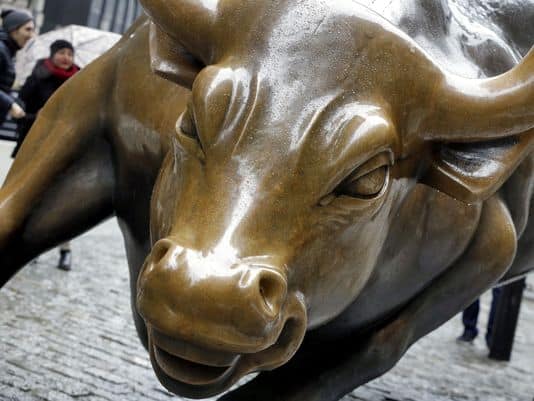
The current bull market in stocks is a month or so away from becoming the longest in history. If it happens, then what?
Many along Wall Street expect the rally that began in March 2009 to eclipse the 1990-2000 run that ended with the dot-com crash. But a growing number of experts are questioning whether the stock market’s run will keep going through 2019 and beyond.
The big threat now is the potential for a punishing trade war, as the United States squabbles with allies and rivals alike on tariffs. That could squeeze earnings and economic growth around the world.
Beyond that, several firmer warning signals for the market are flashing yellow. Here’s a look at some of them:
The yield curve
This is a somewhat inscrutable signal, hidden in the recesses of the bond market, but it’s been an accurate one.
When yields for long-term bonds drop lower than yields for short-term bonds, it’s what economists call an “inverted yield curve.” It indicates that investors are forecasting a weaker economy and inflation in coming years. An inverted yield curve has also preceded each recession of the last 60 years, though sometimes by more than a year.
Inflation
Prices are picking up across the economy, particularly for businesses, after years of ultralow inflation. Prices for businesses rose 3.4 percent last month from a year earlier, the biggest jump since 2011.
For companies, higher inflation erodes profits unless they’re able to raise prices. For consumers, it saps their buying power.
The Federal Reserve has already indicated it may raise interest rates two more times this year, and an acceleration of inflation would push it to pick up the pace.
Higher interest rates have historically hurt stocks and other risky investments. Record-low interest rates helped prop up stock markets for most of the past decade.
Debt
Companies are famously hoarding great piles of cash, but they’re also sitting on ever-growing piles of debt.
Total debt among non-financial U.S. companies is at a record high, relative to the size of the U.S. economy. As the Great Recession demonstrated, high debt levels can leave companies, families and anyone else particularly vulnerable when an economic shock arrives.
If interest rates do continue to climb, so too do borrowing costs for companies.
Growth outperformance
Investors are pouring money into stocks of companies that are growing quickly, such as big technology companies. These growth stocks are trouncing what are called “value stocks,” which are companies that look cheap or have big dividends.
Investors have switched allegiance back and forth between growth and value stocks, and each time, the outperformance has peaked just before or after a market top for the S&P 500, such as in 2000 and 2007.
M&A and IPOs
Companies around the world are buying each other as they hunt for growth, and this year is on pace to be the highest for mergers and acquisitions since 2007. Companies are also going public in hopes of cashing in on the hot stock market, and this past quarter was the busiest for IPOs in three years, according to Renaissance Capital.
Activity for both buyouts and IPOs tends to peak around market tops.
But for now …
Of course, this bull market has run through all kinds of warning signs and proven its skeptics wrong time and again. Rising from the ashes of the financial crisis, it’s famously been one of the most unloved bull markets in history.
Surging corporate earnings due to lower tax rates and a strengthening economy should give the market more fuel this year. Plus, one important ingredient for a market top is still missing — the wave of buying that comes as investors succumb to the fear of missing out, said Matthew Miskin, market strategist with John Hancock Investments.
“The yield curve is not inverted yet, and earnings are still good,” Miskin said. “It’s not there yet, but you want to have a plan of attack for when all these dominos do fall.”























